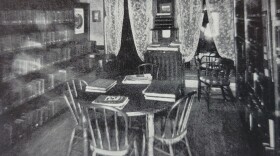Few people know that the Northwoods was once exposed to intense radiation for scientific research amid fears of nuclear war. Fifty-one years ago, a site near Rhinelander, Wisconsin, was developed to study radiation’s effects on northern forest ecosystems, known as the Enterprise Radiation Forest Project.
In the 1960s, fearing nuclear confrontation, the Atomic Energy Commission and Department of Agriculture studied radiation’s potential impact on U.S. environments. In 1968, a meeting at the Northern Institute of Forest Genetics near Rhinelander, now the Forest Service Northern Research Station, led to large-scale studies on forest flora and fauna. Geneticist Dr. Thomas Rudolph was chosen to lead the project.

A 1,440-acre site in Enterprise, 40 miles north of Wausau, was leased, and enclosed by an 8-foot fence topped with barbed wire in 1971. A research building off Hwy Q served as the sole access point, housing equipment to safely conduct the experiment from over half a mile away.
A radiation site, Site 1, was chosen where three forest types converged. Pre-radiation data was collected, and local experts helped document the forest’s logging history. Deer were relocated or hunted before the project began, but rumors of secret government activities persisted.

In August 1971, a gamma radiation sample from Puerto Rico was re-encapsulated with 10,000 curies of Cesium 137 and transported to Site 1 in September. A platform was constructed to hold the Cesium sample, which was raised above ground to irradiate the surrounding forest.
Eleven thousand feet of electrical cable powered the equipment, with the last 500 feet buried for protection. Safety was critical; ten keys were required to start the process, with fail-safes in place.
Irradiation began on May 3, 1972, emitting gamma radiation potent enough to be lethal at close range. The forest was irradiated for 20 hours daily, with the remaining time reserved for study. Rudolph assured that when the Cesium was encapsulated, there was no detectable radiation threat.
Hundreds of trees, plants, and animals were studied, with meticulous data recorded. Despite outreach, Rudolph had to address local concerns about the experiment’s impact. The project, originally planned for 20 years, was discontinued on October 16, 1972, after a single growing season due to funding cuts. The team continued gathering data, publishing their findings in 1978.
The site was shut down, the fence removed, and the Cesium sample retrieved. The property reverted to public forestland, with no long-term radiation effects observed. Today, the site is a thriving forest, with only a few remnants of its important atomic research history.
Source: The Enterprise Wisconsin Radiation Forest by Thomas Rudolph 1974, Interviews with Terry Strong, and Ed Bauer by Tyler Schilling









